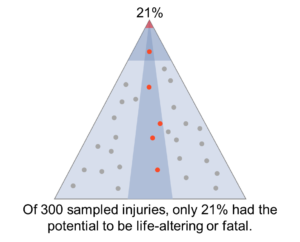September 29, 2017
Building Capability in SIF Prevention Through Data-Driven Innovation
 It’s been nearly a decade since our first SIF study explained why so many companies were seeing recordable injuries improve while fatal injuries were level or increasing. Dr. Tom Krause, with collaborators from 9 global organizations studied the problem in 2010. They concluded that the disturbing trend was the result of differences in the situations leading to serious and fatal injuries compared to other types of injuries.
It’s been nearly a decade since our first SIF study explained why so many companies were seeing recordable injuries improve while fatal injuries were level or increasing. Dr. Tom Krause, with collaborators from 9 global organizations studied the problem in 2010. They concluded that the disturbing trend was the result of differences in the situations leading to serious and fatal injuries compared to other types of injuries.
This work demonstrated that the traditional approach to safety improvement is ill-advised. For decades, the strategy was to reduce exposure at the bottom of the safety triangle in hopes that serious and fatal injuries would follow. Today we know that a top-down strategy would be more effective: Focus on SIF precursors and supplement those efforts as needed in order to reduce all categories of harm.
Uneven Progress
The global safety community has made progress integrating the new view into existing safety programs, but progress is uneven. For example, some organizations report SIF potential data all the way to their CEOs. This is positive and brings focus and attention to SIF prevention efforts. However, just as many organizations have stalled, stuck in the quagmire of well-established systems and deep attachment to familiar metrics. Further, many safety leaders still struggle to recognize SIF precursors in their plants, let alone use precursor information effectively.
One organization, for example, has been aware of the original SIF study for over 6 years. Despite significant efforts to reduce SIFs, its leaders still do not agree on what a SIF is. They don’t agree on what situations have SIF potential. This lack of alignment has blocked progress and they stalled.
Collaborative Innovation is Needed
Experience has shown that a group of organizations sharing experience, data, and expertise is a cost-efficient way to quickly build capability. Such a strategy can yield high quality, actionable information aimed at the groups’ specific objectives.
A single organization taking on the problem alone can spend years of study and millions of dollars. In the end, results don’t begin to match the learning potential of a collaborative approach. We believe the common value for safety and shared goal of preventing every serious and fatal injury represents a unique opportunity for a rapid learning model that will uncover methods to accelerate improvement.
More to Learn
Experience has taught us that leadership sets SIF improvement in motion. Our own research demonstrated that site-level leaders’ decisions play a major role in injury causation and prevention. Incident investigations show time and again that when SIFs happen, it’s almost always the case that layers of protection were compromised well before the event took place. Further, we realize that the way leaders go about solving these problems impacts culture, and culture affects all areas of performance well into the future. Unfortunately, knowledge of these factors and using them to improve are different things.
Every organization has more to learn, but different organizations are in different places on the journey.
Search for articles
Share this post:


